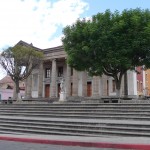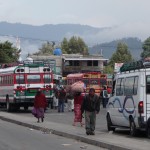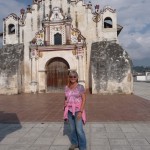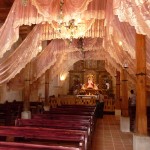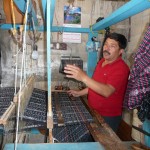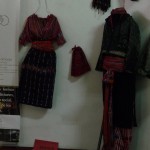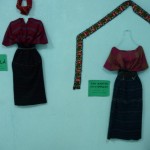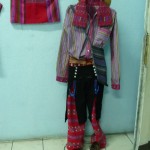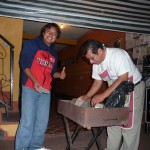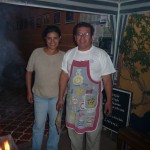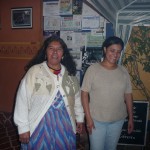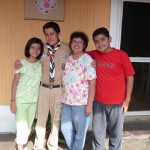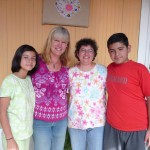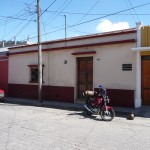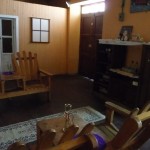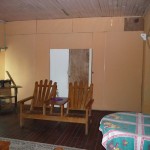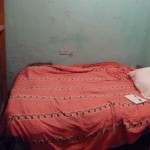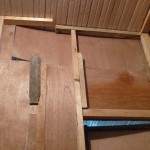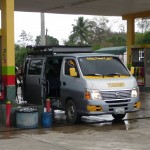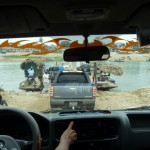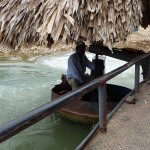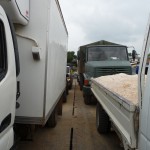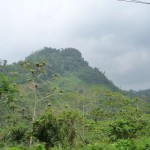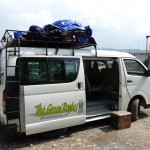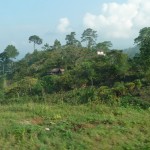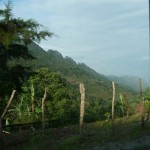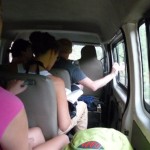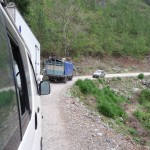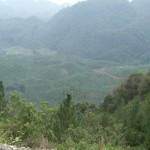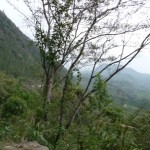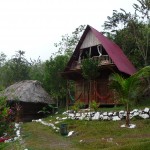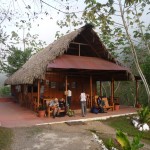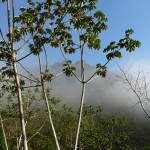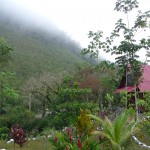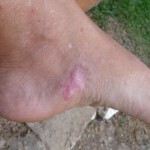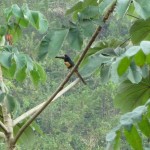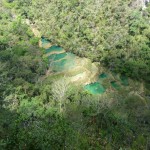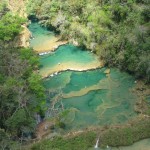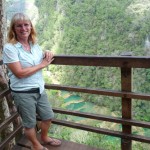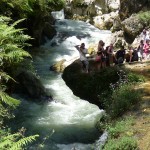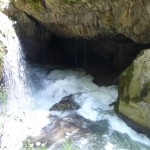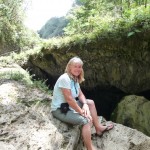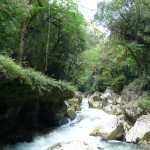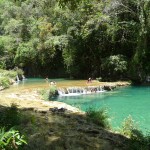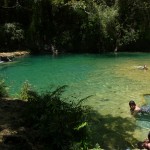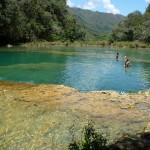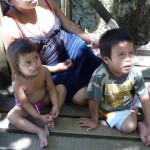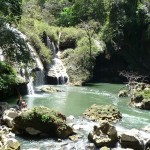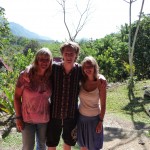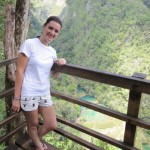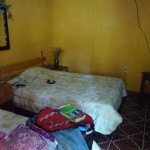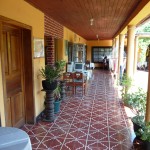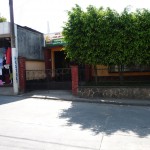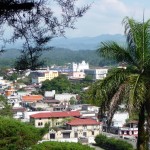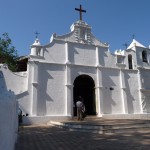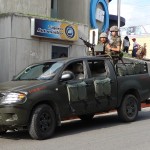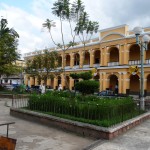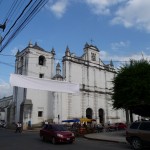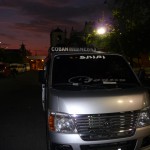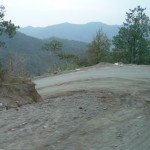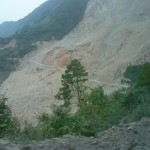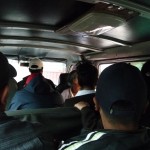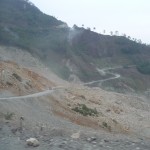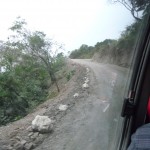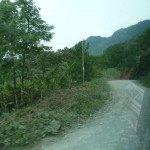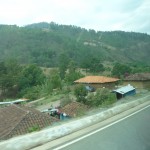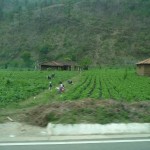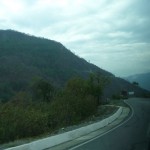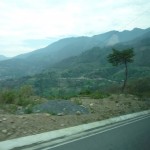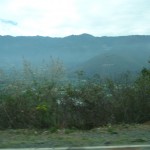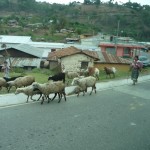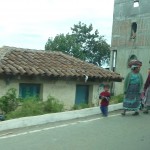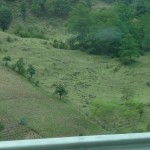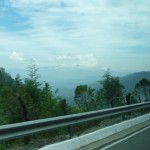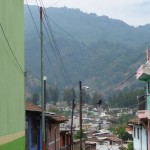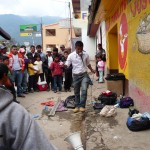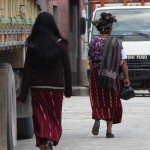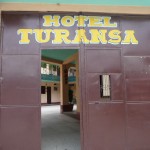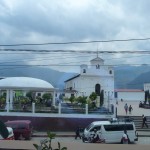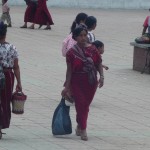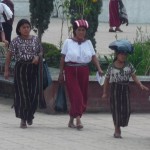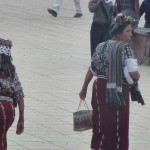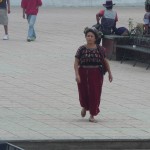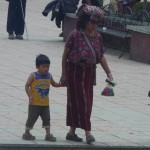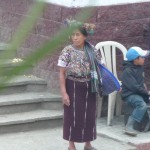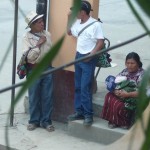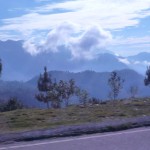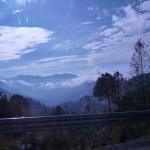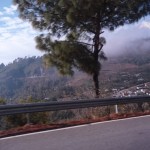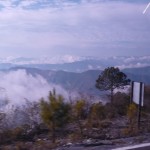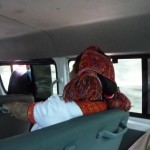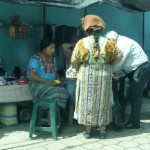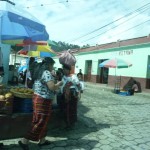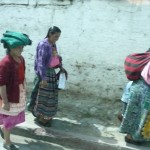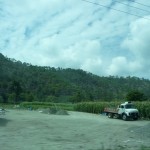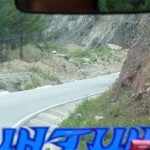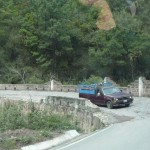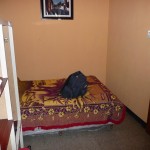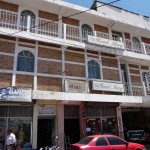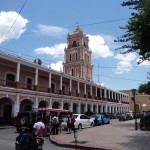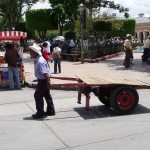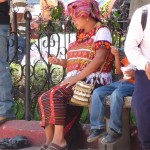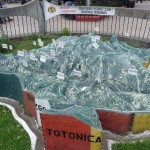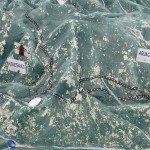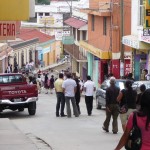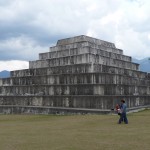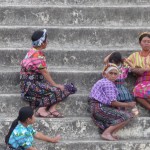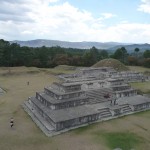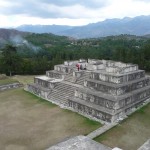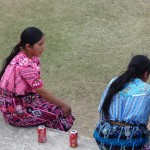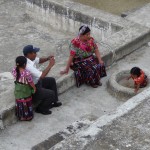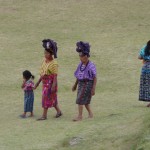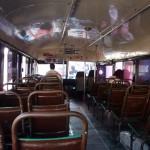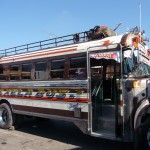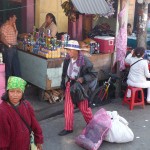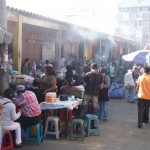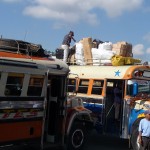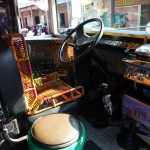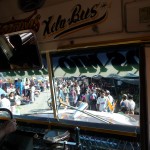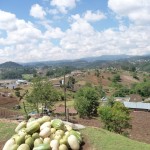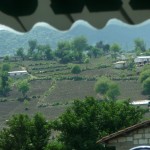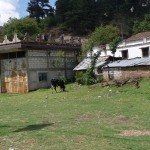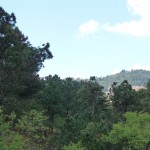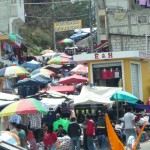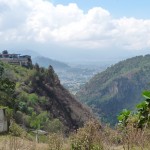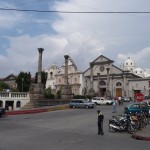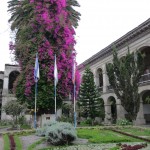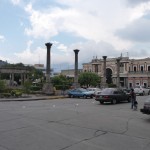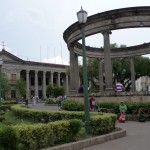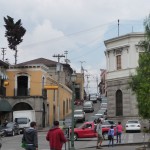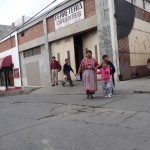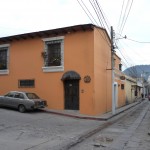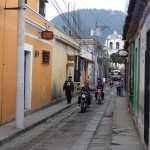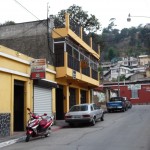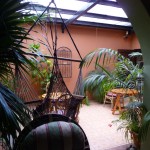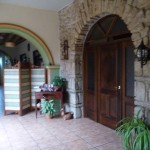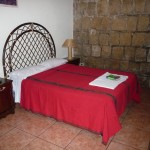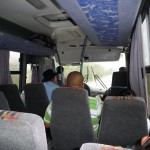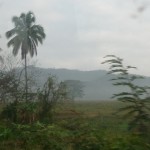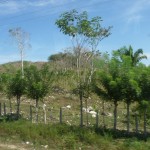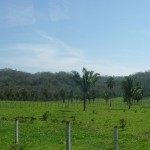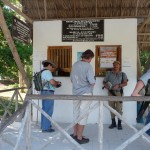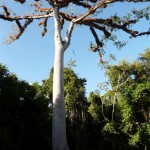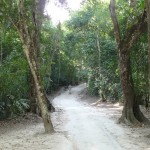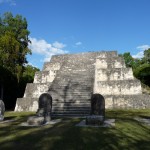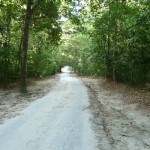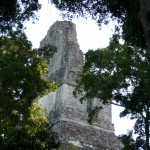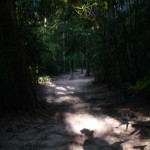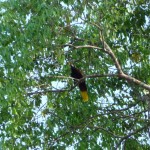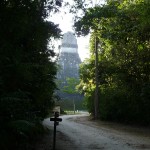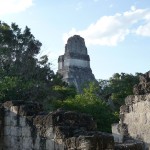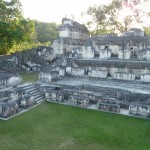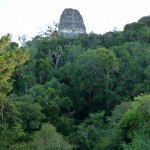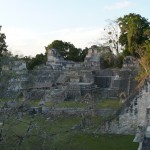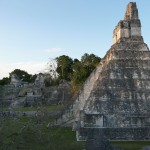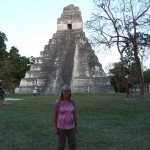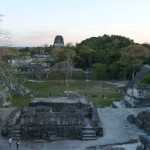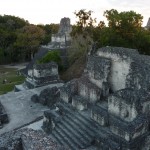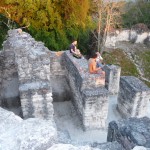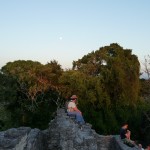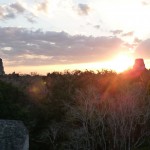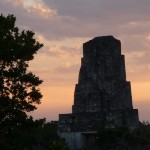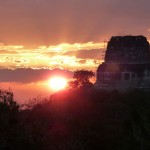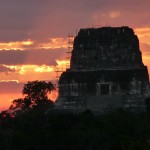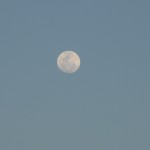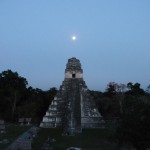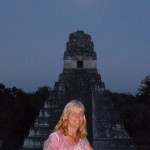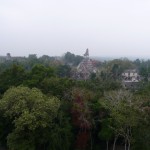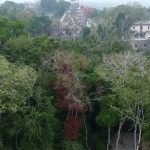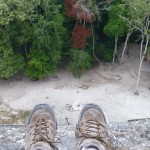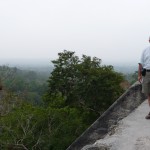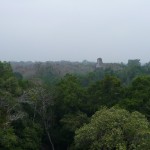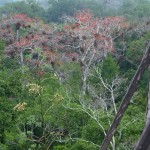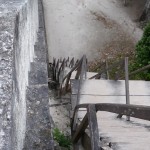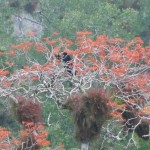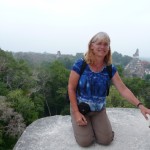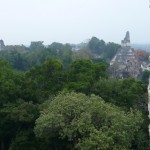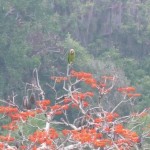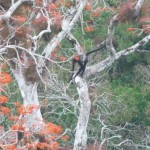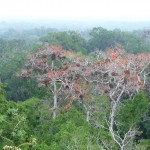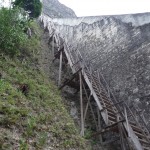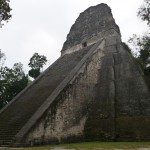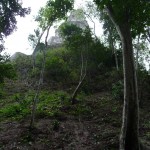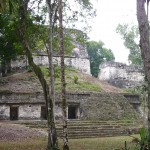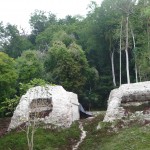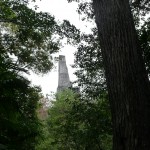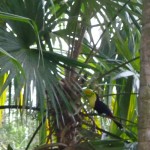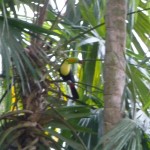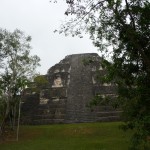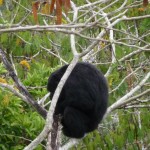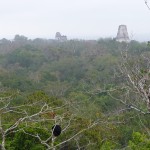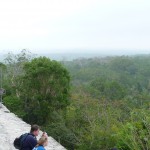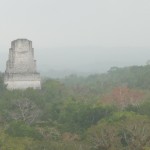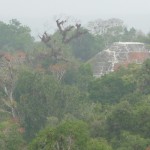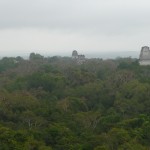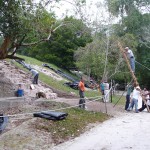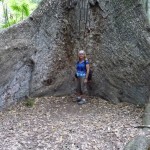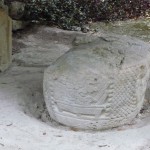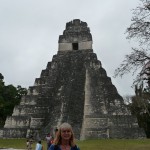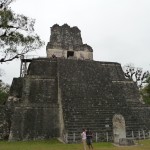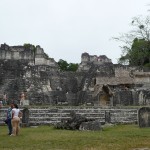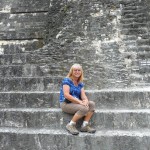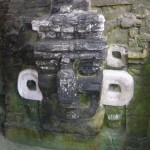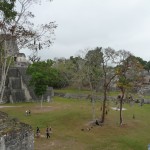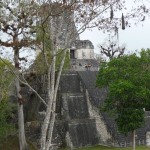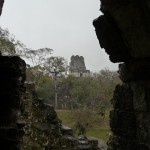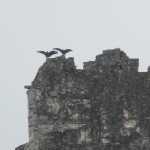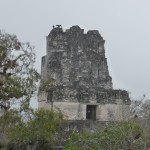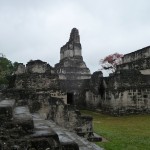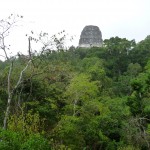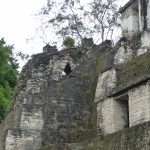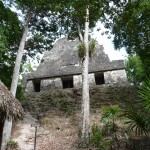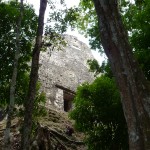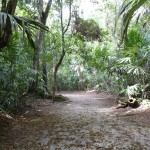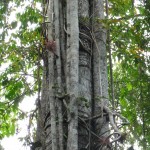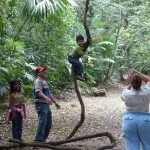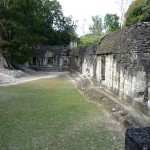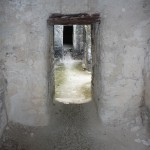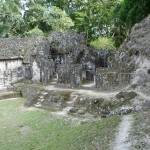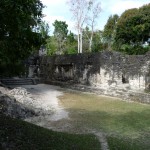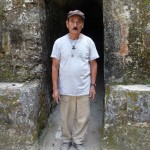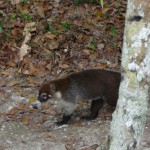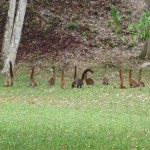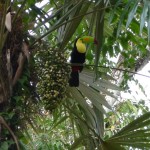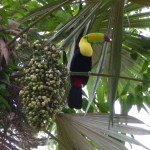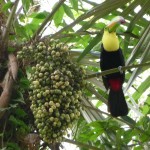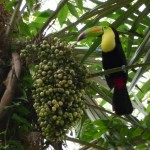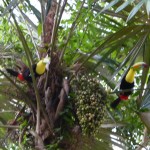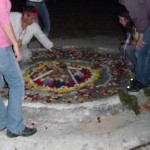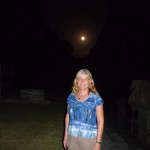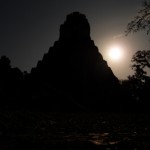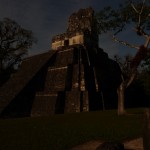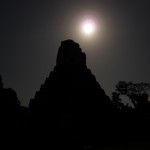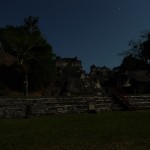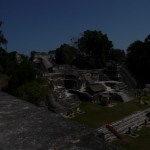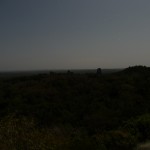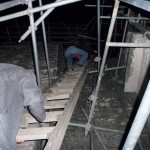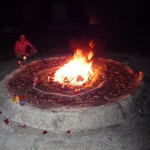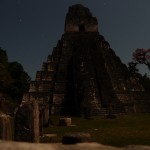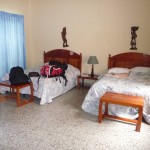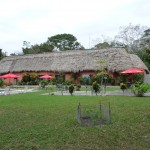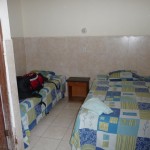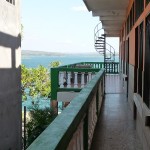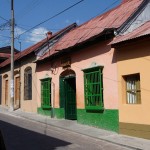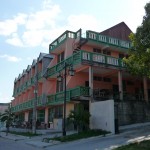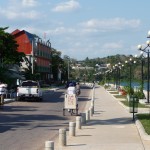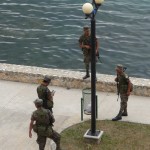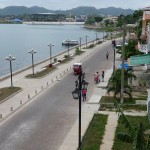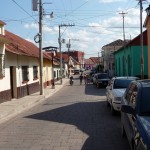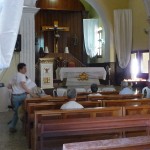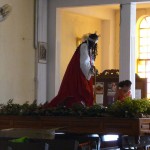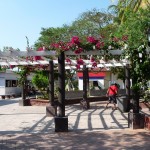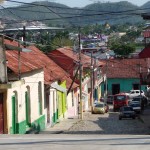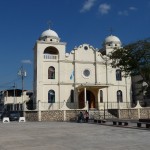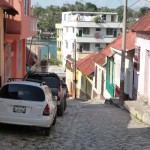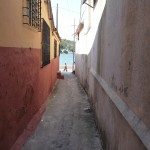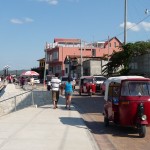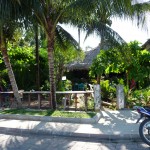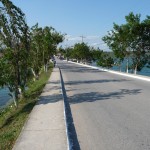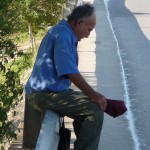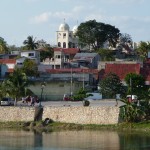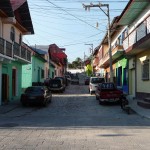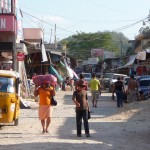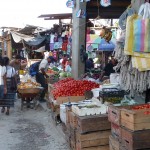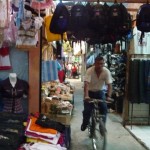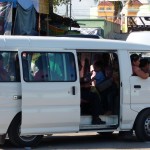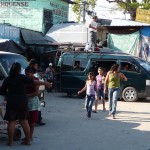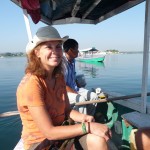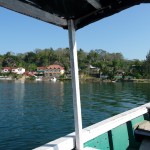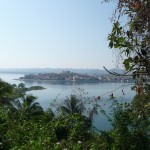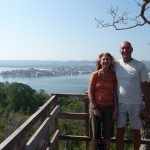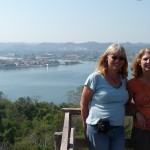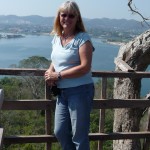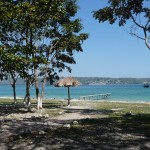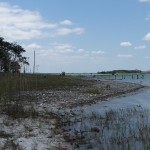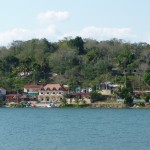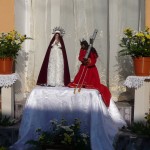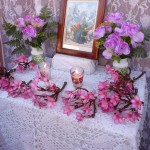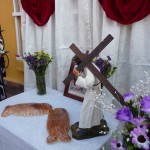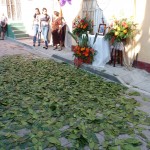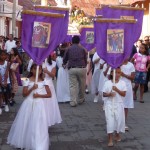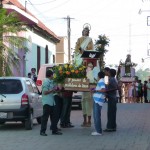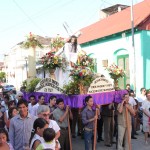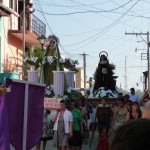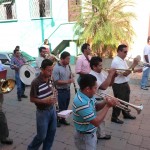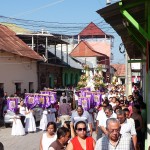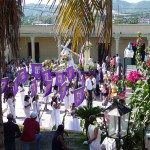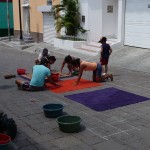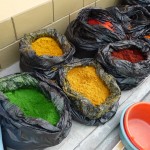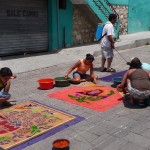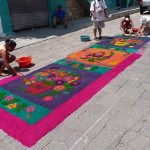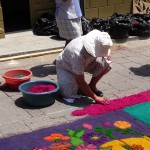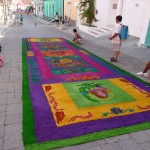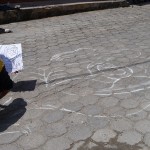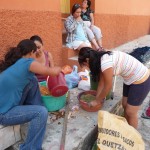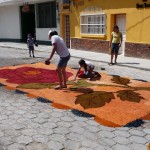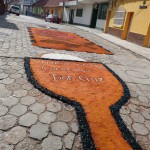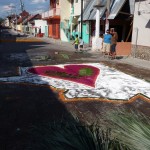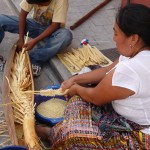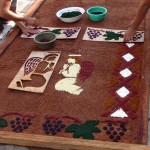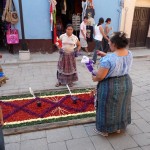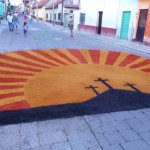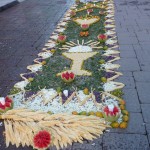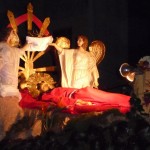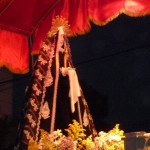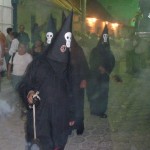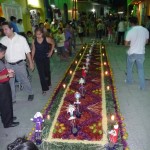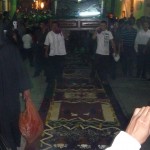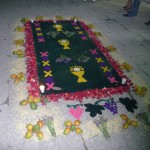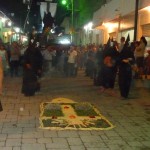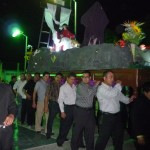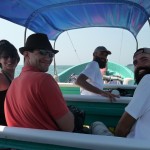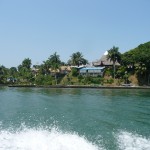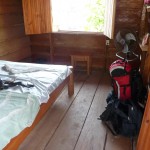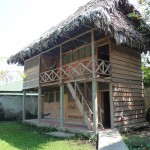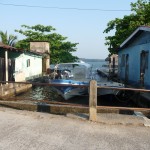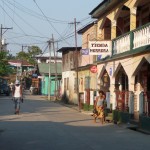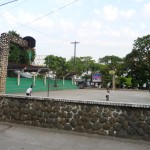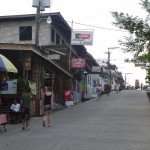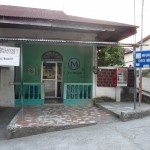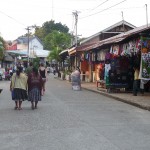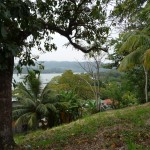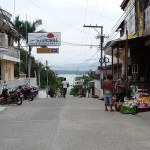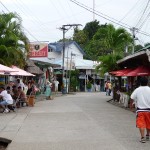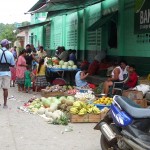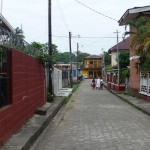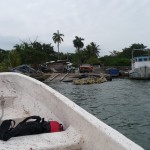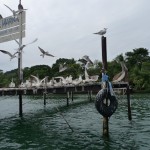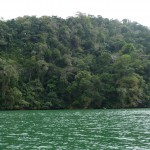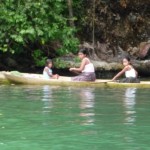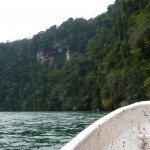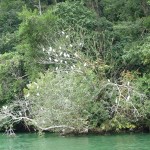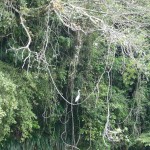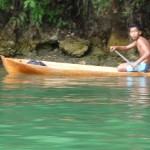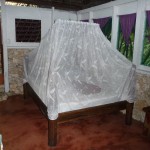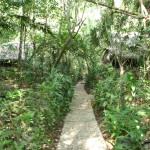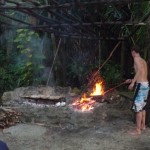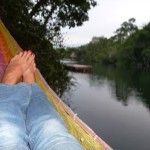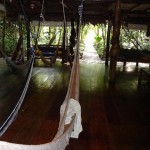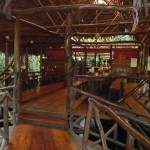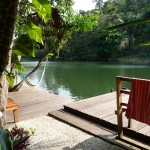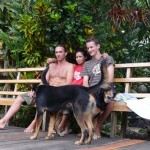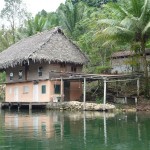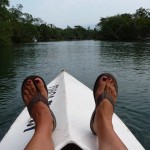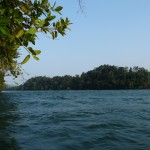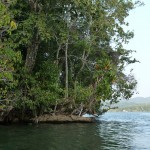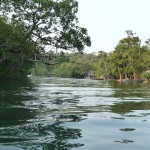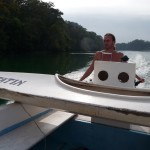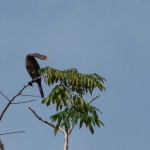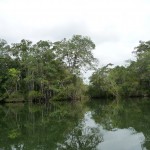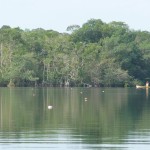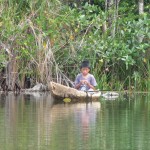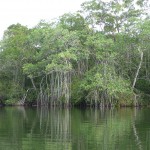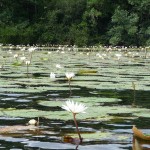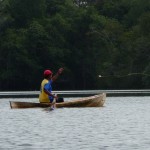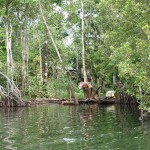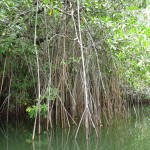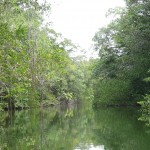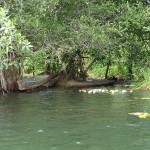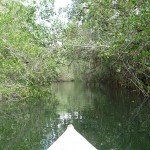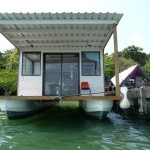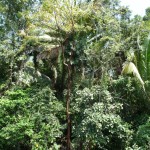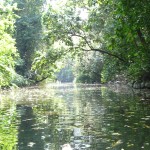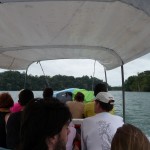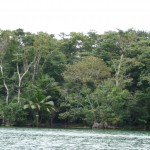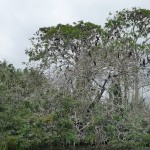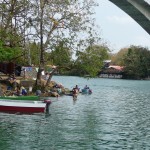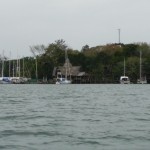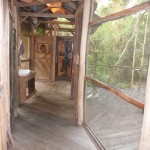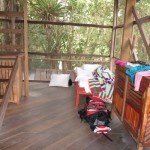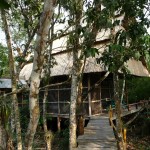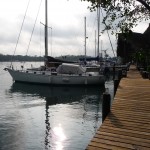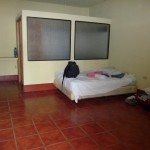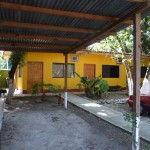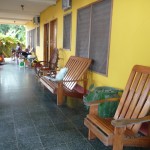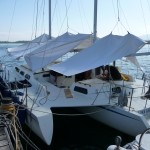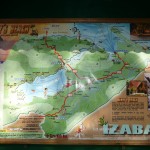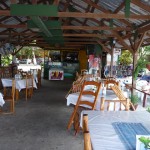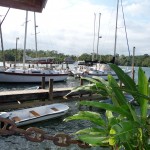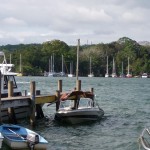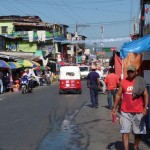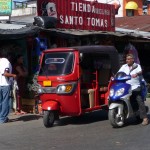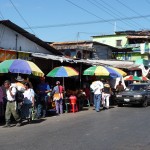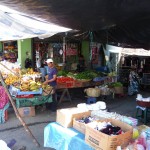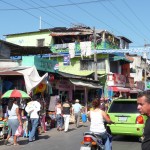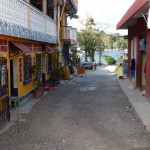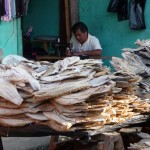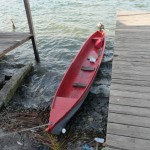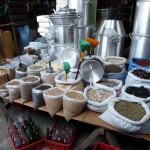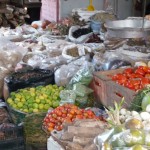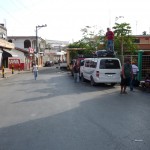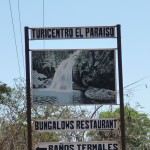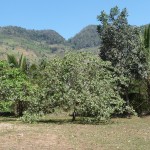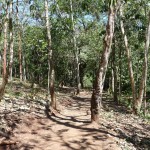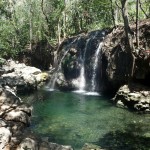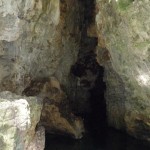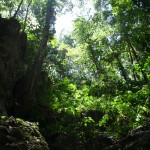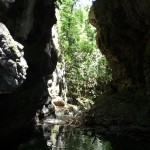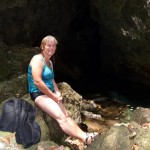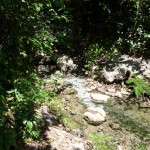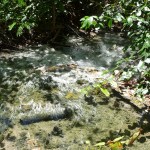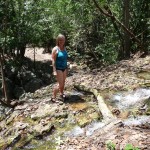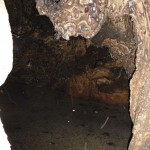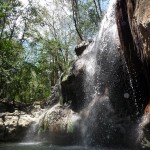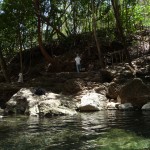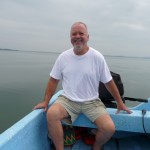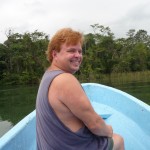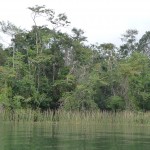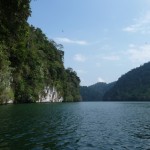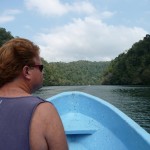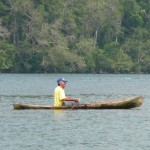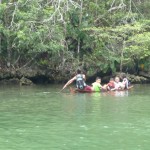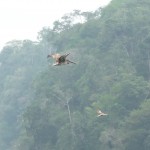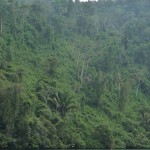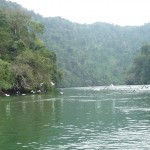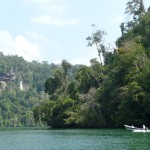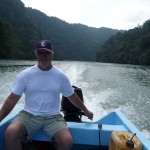The beeping alarm startles me from a deep restful sleep. I am momentarily confused.
“What day is it?” I ponder. “And why was I getting up so early?”
“Oh yeah,” I finally remember, “It is Monday morning, and I am going on a sunrise tour of Tikal.”
With nothing but a flashlight to help me gather my necessary belongings, I fumble around in the thick darkness for more than twenty minutes. I had been surprised to learn yesterday that the hotel’s electricity is generator-based, and the rooms only have power from 6-10 p.m. every night, and from 6-8 a.m. each morning.
Conversations with Impatience
I quickly put my flashlight away as our eager and excited group of eight steps out of the dark hotel lobby. A faint morning glow already provides sufficient illumination.
A persistent feeling of impatience attempts to shatter my peace. A friend told me that the best time to see monkeys in the park is during the few minutes right after sunrise—and apparently I have developed a strong emotional attachment to such an event. Our group seems to be moving slowly, and then stops while one man runs back to the hotel to retrieve money for admission.
“It is OK Brenda.” I reassure those agitated ego thoughts. “Everything is exactly as it should be. Breathe deep. Return to the present moment; return to the here and now.”
With a feeling of deep peace, I glance at my watch as we pass the entrance guard who is checking for valid tickets. The time reads 5:55 a.m.—we are still ahead of schedule, as the gate does not technically open for five more minutes.
I take another deep breath and inhale the cool moist air around me. I am not especially interested in hearing Ricardo talk today, so I walk slightly ahead of the group, focusing on the incredible energy I feel emanating from everything around me.
“We’ll go straight to the top of Temple V.” Ricardo tells us. “That will be a beautiful place to enjoy the awakening jungle surrounding us.”
“Oh, there are some spider monkeys in those trees.” Someone exclaims as they point up beside the trail.
Our whole group stops and pulls out their cameras. Meanwhile, ego thoughts are flashing through my brain impatiently saying “C’mon, let’s go—I want to hurry into the ruins so I can see the monkeys before they scatter.”
I later laugh at myself as I recognize the irony of such thoughts.
After resuming our journey, Ricardo quickly stops to point out a colorful bird high in the trees above us. Focusing on maintaining my peace, I remain about 30 feet up the trail, deeply breathing the fresh jungle air, enjoying the peaceful relaxing calm around me.
“I can guarantee that Temple V will still be there when we arrive.” Ricardo teases me with a lighthearted jab.
I had no idea my internal wrestling match with impatience was so obvious. For the most part, I have remained very peaceful, simply observing my own impatience, almost laughing at the little internal tantrum that ego is trying to throw.
I again take another deep breath, silently thanking my anxious thoughts for trying to get me to the ruins a few moments earlier. Then I gently reassure those unspoken thoughts that everything is under control—everything is perfect.
Soon, I get my first close-up glimpse of Temple V. This towering temple is the second tallest in the park, rising to around 190 feet. The stone staircase at the temple’s front is off limits to tourists, due to the fact that it is very steep and dangerous. Instead, an even steeper wooden staircase has been constructed at the left front of the temple, against an area that is nearly vertical.
With no thoughts of delay or fear, I immediately begin my tedious ascent. The staircase is more like a steep ladder with handrails. Small platforms provide a tiny resting spot about every fifteen feet. The exhausting climb ends nearly 150 feet above the distant ground below. The walls of the temple spire rise vertically from here; we are as high as visitors are allowed to go.
As I locate a beautiful stone step on which to rest and view my incredible surroundings, I have one final conversation with those impatient ego thoughts.
“See,” I tell these confused little feelings, “we are here in plenty of time. There was nothing to fear. The view is incredible, the energy is unbelievable, and all is perfect.”
The uninvited stowaway feelings simply melt away into the beautiful morning mists that surround me.
Magical Morning Mists
Breathtaking! Magical! Awe-inspiring!
Words are entirely inadequate in describing the panoramic splendor laid out beneath my feet.
During the night, a light cloud-cover has snuggled in above, preventing any direct sightings of the sun—but this fact simply makes the morning even more mysteriously tantalizing. The indirect glow of diffused morning light simply adds to the special energizing visual effects.
My ancient stone perch is high above the surrounding treetop canopy—perhaps twenty or thirty feet above the colorful leaves, flowers, birds, and monkeys that live in this rarely-visited world. A delicate layer of thin foggy mist hovers throughout the trees, stretching in all directions for as far as the eye can see.
And then there are the majestic ruins. As I look directly out to the north, I now have a spectacular view of the Grand Plaza laid out a few hundred yards across the lush jungle-filled valley in front of me.
We remain in this meditative paradise for nearly an hour. Ricardo continues his tour-guide conversations with a young couple over by the wooden stairs, while most of us simply inhale the splendor in reverent silence.
I watch as several spider monkeys climb on the thick branches of a tree below and to my right. Just above the monkeys, several green parrots squawk and dance as they chase each other from one colorful flower-covered branch to another. High in the grey skies above, the occasional falcon glides gracefully through the misty morning air.
It is with great hesitation that I begin my downward descent from such a sacred experience. Yes, slowly backing down the steep staircase causes me to hold my breath—but my hesitation is not from fear. It stems from the fact that I simply do not want this experience to end. I could remain here for many hours to come, simply vibrating with the magical energy all around me.
Teasing Toucans
Minutes after reaching solid ground below, we are again walking beneath a canopy of thick jungle. After a short hike, we emerge into a large plaza. Directly before us I see a more traditional looking pyramid—a broad-based, triangle-shaped pyramid named “The Lost World.”
But these beautiful ruins are not the sole captors of my interest. I also find myself spending considerable time studying the canopy of trees above. I have a secret desire to see my first Toucan bird—and Ricardo has assured me that such a sighting is a definite possibility.
Five minutes later, as we are again walking through the jungle, Ricardo and the main group are distracted by a search for some type of falcon above. Knowing that they will surely call when they find the large bird, I continue to scour the trees in my own personal quest.
Suddenly I see the little fruit-loops bird sitting on a branch about thirty feet above me. Immediately I call out to the rest of the group.
“It is a Toucan.” I exclaim with the enthusiasm of a three-year-old child. “Over here! There is a Toucan right there in that tree.”
While the rest of the group begins to rapidly approach my position, I whip out my little camera with eager intentions. Almost immediately the illusive little green-and-yellow-billed bird flaps his colorful wings, disappearing into a treetop about thirty feet away.
Our whole group continually runs from one position to the next as we attempt to find an unobstructed view of the constantly moving bird—a bird who seems to be skillfully engaging in a teasing and playful game of “Hide and Seek.”
Finally, the beautiful bird poses long enough for me to capture several photos. In my haste to rapidly snap away on my shutter, my fully zoomed lens results in blurred images. Only two slightly blurry photos are clear enough to keep.
“Finally, after all this time I get to see a real Toucan.” I hear one of the guys in my group excitedly exclaim behind me. I just giggle inside as I realize that he is reading my mind.
Before any additional photo poses are possible, the illusive little large-billed bird disappears into a thick jungle backdrop and we again resume our onward journey.
Renewed Heights
On the way toward Temple IV, we pass through yet another beautiful lesser plaza—an area known as the Seven Temples Plaza. As we pass briefly through this remote peaceful complex, something registers in my heart—a feeling peacefully whispering that I will be returning by myself later in the day.
After what seems like an endless jungle hike, we finally reach the base of the tallest temple in Tikal—Temple IV. This is the same massive structure that provided an amazing backdrop for last night’s sunset—the same huge temple that had towered above the dense jungle more than a kilometer to our west as the yellow-orange sun danced around its glowing silhouette—a tall steep structure that towers around 210 feet above the thick green jungle below.
The wooden staircase leading up the southern side of this temple is much easier to climb, with a series of switchbacks gradually leading to the top—at least to the top of where tourists are allowed to go. As with temple V, the staircase empties onto a wide stone ledge, in the middle of which stands a taller, almost vertical spire jutting into the cloudy sky above.
A small howler monkey, sleeping in nearby tree-top branches, completely ignores his popularity with passing cameras.
The vista from Temple IV is equally as impressive as the view from Temple V. From here, I can see the distant tops of Temples I, II, III, and V scattered around in the misty jungle before me.
Again, Ricardo gives us ample time to simply sit and absorb the ambient energy of this unforgettable panorama.
Our guided tour ends with yet another visit to the Grand Plaza, where Ricardo guides us through areas that we had not yet seen in last evening’s twilight. But my mind is already in solo mode as a light drizzle begins to fall. Shortly after 10:00 a.m., Ricardo begins to guide the group back toward the main entrance, more than twenty-five minutes away.
“Is our tour over?” I ask hopefully.
“Yes, we are just heading back to the hotel now.” Ricardo replies.
“If it is alright with you then,” I ask in a way that is more of a statement, “I think I will just remain here and enjoy the park on my own.”
Misting Meditation
As I begin to explore remote rooms of the Central Acropolis—a small complex of ruins on the south edge of the Grand Plaza—a small cloudburst begins to drench the plaza below me. I watch as the crowds of tourists—tourists that have greatly increased in number over the past thirty minutes—begin to scatter and disperse.
With a little umbrella in hand, I stand peacefully on a ledge, fully energized by the tiny droplets of rain pattering all around me—yet still trying to protect my hair and clothes from the fresh morning moisture.
After about fifteen minutes of standing motionless in the morning mists, I spy a small sheltered cave-like opening in the ruins above and to my right. After five minutes of maneuvering through meandering passages and walls, I slip over a low wall, pull up a flat rock, and sit near the front of my new-found hideout. I have a beautiful view of the plaza below and to my right—a view which I silently inhale for nearly thirty minutes.
As the rains subside, I watch with awe as two large falcons spread their wet wings atop the tower of Temple II. These large birds simply stare at the slowly resuming activity below while their wings gradually dry in the warmth of slightly clearing skies.
As a strong desire for sleep soon begins to overpower me, I locate a sheltered room with a window that opens to a spectacular view of Temple V to my south. In a matter of seconds, I am using my lumpy daypack as a pillow while laying flat on my back. I barely notice the cold hard rocks below me, as my body fades to a state of near-sleep.
The unexplainable craving for sleep persists, and I opt to begin a return journey to my hotel.
“I will eat some lunch, take a short nap, and then return to the Seven Temples Plaza.” I tell myself.
Perfect Timing
As I gobble down a simple cheeseburger and fries for lunch, my appetite is barely satisfied. I reassure myself that tonight I will eat a larger dinner to compensate. Soon I am resting comfortably in the darkness of my room, with thick drapes blocking out the early afternoon light.
Suddenly I feel a burst of energy, accompanied by a small but distinct feeling that it is now time to get up and get going.
I feel quite amazed by the sudden absence of exhaustion that was formerly pulling me into the sheets. Within five minutes I am leaving the darkness of my room. The skies are blue and the hot sun is now shining. I pause and almost remove the sweatshirt from my daypack—but a little feeling urges me to leave it put.
In ten minutes, I pass the security guard and approach a large sign containing a map of the park’s expansive trails.
With intentions to verify the most direct route to Seven Temples Plaza, I feel a little whisper in my heart.
“Take the path to Temple VI.” The little Jedi voice silently resonates. “You haven’t been to Temple VI yet … you know you want to walk in remote jungle … this isolated little temple is more than a kilometer out in the middle of nowhere … you will love it … go there now … go.”
After twenty five minutes of peaceful walking through shaded jungle canopy, I arrive at my prompted destination—Temple VI. As I slowly walk around the perimeter, I feel no special energetic draw, nothing urging me to stay for a while.
In the absence of firm promptings, I am soon following another remote path—this one leading in a more northwesterly direction, back toward the main park—back in a direction which will eventually guide me to the Seven Temple Plaza.
After twenty minutes of beautiful peaceful strolling, I pass a small complex of ruins on my left—a less visited area simply called “Group G”.
Curiosity gets the best of me, and I decide to have a look at what appears to be a less-than-impressive cluster of old rooms and walls. As I approach a small entryway into the complex, I notice a gardener raking leaves under some trees in a clearing to my left. His rake is nothing more than an old tree branch with a cluster of smaller twigs on one end.
“Buenas tardes (good afternoon).” I say politely, as I begin to pass by, fully expecting the conversation to end as quickly as it begins.
“Buenas tardes.” He replies, quickly adding, “Where are you from?”
Within a few minutes of casual, but energizing conversation, the man drops a bombshell.
“I am a Shaman.” He tells me.
My mind flashes back to a conversation I had months ago in Cozumel with my dear friend Eduardo—a conversation in which he told me that often, Shaman and spiritual protectors work in and among the ruins in very inconspicuous roles, while silently watching over the ruins.
“It is a great honor to meet you.” I reply, not really knowing what else to say.
In my mind I quickly review a simple but amazing sequence of events and tiny promptings that have guided me to this very place, at a moment in time when this humble man would be standing right before me. I later learn that the timing was perfect.
Floating on Clouds
“This small structure has a very powerful connection with the moon’s energy,” the sweet man tells me.
“Tonight is a full moon,” he adds, “and I will be performing a ritual here with candles and incense.”
“Oh,” I interject pleadingly, “I would love to experience that. Would it be possible for me to come back here this evening to participate in your ceremony?”
“Yes, that would be fine.” He responds. “I need to go home for a while, but I will be back here around 5 or 5:30. Just show up at 5:30 p.m. and I will be here.”
“Come here.” He then asks gently as he extends his open arms. “I have been born with the gift of being able to see into people’s hearts.”
“Don’t be afraid.” He whispers as he wraps his arms around me in a huge tight bear hug.
“I am not afraid at all.” I whisper back, as I melt into his deep warm hug, briefly sharing all of my emotional energy with this unknown man.
Minutes later, he releases his embrace, pulls back, and looks me in the eyes.
“I have seen into your past,” he tells me. “You have had a very difficult life with much deep heartache – but you are through that now, your energy is very powerful and positive.”
Then he tells me something that does not register quite so true with my soul.
“But your heart is sad.” he tells me. “You are alone, and do not have anyone in your life. There is an energy blockage in your heart chakra.”
“It is true that I am not in a relationship.” I tell him, “but my heart is not sad. I have never felt more whole and more alive.”
But then, on the odd chance that he might be right about an energy blockage in my heart chakra, I ask him out of curiosity if there is anything he could do to help open up my energy flow.
“Why yes,” he replies. “I could do an energy massage on you. In fact we could do it right here tonight after we finish honoring the full moon.”
“But if it rains.” He adds cautiously. “You can come to my home and I will perform the massage there. Just ask anyone at the front gate to direct you to the home of Francisco (not his real name). They will show you right where I live.”
“Please, enter.” Francisco tells me as he points to the small doorway of the ruins. “Take a look around the ruins and enjoy the energy.”
As I enter the small tunnel-like maze that leads into the ruins of “Group G” my heart is alive with energy. Small tears of joy well up in the corners of my eyes.
“Is he really a shaman?” I ask myself. “Is this spiritual fantasy really happening to me?”
I simply pinch myself to make sure I am not dreaming.
Bursting Bubbles
After exploring “Group G” for more than twenty minutes, I walk back out through the outer wall, hoping to find Francisco—hoping to be able to capture a quick daylight photo.
As I look around, he is nowhere to be seen. Then, as I turn around to leave, I notice Francisco coming out of a small passageway in the stone wall. I approach him and ask for permission to take a photo.
“I am very ugly he responds.” Making me think he is saying no. Then he motions for me to follow him to the doorway in the wall. Seconds later he poses—but makes no attempt to smile.
“I am a shaman of the dragon—but I am a shaman of light, not of darkness.” He tells me. Then he points to the ground on both sides of his feet, showing me that the doorway represents a dragon, with the dragon’s front paws being found on both sides of the entrance.
“Are you in a hurry?” Francisco asks.
“Actually no,” I reply. “I have lots of time.”
“Then I would like to chat with you right now, if that is OK?” Francisco asks as he motions for me to follow him back into the ruins.
Soon, we are standing behind a tall wall in a narrow open-to-the-sky hallway. Francisco sets a small machete down on a wall and shows me two tiny rooms, one on each end of the narrow passage, about twenty feet apart.
“During the full moon rituals,” he tells me while pointing to the right, “the man sits meditating in this room over here.”
“And the woman, “he continues while pointing to the left, “sits meditating in that room over there.
“I am a Shaman,” he emphasizes again. “But I did not learn from a teacher, nor did I read a book. I was born this way. I have been given a gift.”
“Look deep into my eyes.” Francisco instructs me. “I can see my reflection in yours. Can you see your reflection in my eyes?”
Actually, I struggle to see any reflection at all. His deep brown, almost-black eyes seem to have no pupil—and do not emit any of the reflective light that I would expect.
“When you see your reflection in each other’s eyes,” Francisco adds, “it means that you have a soul connection with each other.”
“Yes, I can see my reflection.” I respond—noting that I can barely see the reflected outline of my profile.
But I feel confused, as if something is a little off.
“I expected his eyes to reflect joy and light—but they seemed very dark.” I silently ponder to myself. I begin to question, but mostly ignore the incongruence between Francisco’s words and my own personal experience.
“Can we exchange some more energy?” Francisco asks politely.
Soon, we embrace in another warm and powerful hug. After a minute or two Francisco releases his squeeze and again looks into my eyes.
“We have a powerful connection from a previous life.” Francisco tells me. “Today’s meeting did not happen by chance. We were supposed to meet here today. I had a dream last night where I saw you and knew that you would be coming to see me. Earlier this afternoon, two women walked by and I started to think you might be one of them, but I immediately knew otherwise. Then, when you walked by, I knew you had finally arrived.”
“I too feel that we were guided together today.” I respond with a genuine loving tone, wanting so much to believe his words are true. “I also feel that our meeting was not by chance.”
I silently review the burst of unexplained energy that woke me from my nap, the internal voices that silently coaxed me to follow the remote path to Temple VI, followed by a resumed journey toward Seven Temples Plaza—a place that has been calling to me all day.
Yes, the combination of every one of these tiny feelings has guided me to be right here, right now.
“You are half a heart.” Francisco suddenly changes subjects.
“What?” I ask, not fully sure if I understand what he is trying to tell me. Throughout our discussions, minor language barriers have hampered my understanding—but Francisco has been very patient with my requests for clarification—repeating himself, speaking slowly, and using simple vocabulary.
“You are half a heart.” He repeats. “And I am half a heart.”
Still not sure what he means, I again ask him to further clarify.
Immediately he pulls a green heart-shaped crystal from his pocket and shows me visually what he means.
“This is a whole heart.” He begins. “And this side is you, and this other side is me. We complete each other. We have finally found each other at last. We can now be together again.”
Francisco quickly adds. “Have you ever considered living here in Guatemala?”
“No, I haven’t.” I instinctively respond, as I am totally caught off guard by what he seems to be suggesting.
His words do not ring true with my soul. No peaceful energy resonates in my consciousness. No sense of spiritual recognition whatsoever. While I agree that we may have a connection from before this lifetime, I do not in any way feel that Francisco and I have finally found each other, and that we will now live happily ever after in spiritual bliss.
I simply do not believe in the concept of two people with half hearts coming together to make a whole. My internal feelings tell me that healthy relationships happen when two people with whole hearts come together to share in their wholeness.
And I certainly do not feel any such soul-mate connection with this sweet man.
I am beginning to feel very confused. On the one hand, I have no doubt that I was guided to be out here in the middle of the jungle—to be right here, right now.
But on the other hand, my internal feelings are not confirming anything that comes out of this sweet man’s mouth. I want so desperately to believe that he is a Shaman. I fantasize deeply that he will give me some powerful message to launch me forward on my spiritual journey.
“Can we share energy again?” Francisco asks kindly, interrupting my confusing internal mental chatter.
For the third time, I hesitantly embrace this sweet man with my trademark bear hug—a hug which I love to share with anyone, as long as they understand it is 100% a spiritual hug, nothing more.
Soon, I become very uncomfortable as Francisco’s body language begins to suggest that his hugging energy is obviously focused more in the realm of physical contact than spiritual sharing.
I release my grip and patiently wait for him to do the same. He looks me in the eyes and then lovingly leans his forehead into mine, touching his nose to mine at the same time. I feel very uncomfortable, but do not resist. Before I know what is happening, his forehead pulls away and his lips come forward into what I believe will be a simple friendly peck on the cheek—but no, he makes full wet lip contact. It takes me a second or two before my shock turns into action, and I gently push him away.
“I am very concerned about your intentions.” I tell him lovingly but firmly. “I am not interested in any type of physical relationship—no kissing, nothing sexual, nothing at all like that.”
Meanwhile, I am feeling victimized and betrayed. “Surely, a true Shaman would never act in such an inappropriate manner.” I tell myself, not sure if that is a statement or a question.
Every ounce of my experience in the western world tells me that a true Shaman would know how to connect with spiritual love without confusing his feelings with physical attraction.
“Oh no, you misunderstand.” Francisco reassures me. “This is purely an energetic exchange—nothing sexual, nothing physical.”
By now, red warning lights are flashing in the back of my brain. Under any other circumstance I would have long since laid down firm boundaries and hit the road.
But something inside of me calmly and peacefully speaks to my heart, saying: “Brenda … don’t jump to any conclusions … forget everything you think you know … lower your defenses … lovingly play this experience out a little longer … see where it leads you.”
As I walk away, wanting to run as far and as fast as I can, I hear the words come calmly and peacefully flowing from my lips.
“I will see you at 5:30.” I tell him.
As I near the beautiful Seven Temples Plaza, my heart and soul feel as if they are drowning in the depths of a dirty, dark sewer. My spiritual bubble of excitement has been burst—yet I still hang onto a deep ego desire—a desire that desperately wants Francisco to be a real Shaman.
Search for Clarity
As I finally set foot into Seven Temple Plaza, I continue to play back the previous forty-five minutes in slow motion. My imagination and thoughts begin to run wild. I am so confused that I feel incapable of distinguishing between spirit and ego.
“Is Francisco trying to prepare me for some type of Mayan Full-moon Fertility Ritual?”
“If he really is a Shaman, I don’t want to offend him. I don’t want to miss out on an opportunity for spiritual growth.”
“I can’t go back there. I won’t go back there. He is a dirty old man. He is just manipulating me, pretending to be a Shaman to win my trust.”
“But I have no doubt that I was guided out there to meet him. There is a purpose to our meeting.”
“Yet my feelings are so confused when I am around him. He is using me.”
“It will be dark out there during his moon ceremony. The location is very remote, and there will be no one else around. Yes, I could easily overpower him physically—but he has a machete, and probably knows how to use it. Who knows what he might try.”
“But he was so kind and gentle. Yes, his behavior seemed odd and inappropriate, but spirit wants me to let go of preconceived beliefs, to lower my defenses. There must be something to learn from him.”
I try to sit and meditate, but this ping-pong match of mental distractions is too great—and then there are the visual distractions. The universe soon fills my immediate surroundings with amazing array of visual distractions.
Seven Temple Plaza is beautiful in the late afternoon. A large group of over twenty coatis wanders into the plaza, running around to and fro, digging in the grassy plaza, searching for their next meal. The bodies of these cute little coatis remind me of a raccoon—having a hairy torso, a long pointy nose, and various shapes and colors of furry masks around their eyes. The tails of these little creatures remind me of a monkey—several feet long, thin, furry, standing straight up, and curled on the end.
I quickly give up on my mental debate and focus on the delightful antics of these little four-legged creatures. One climbing on the hill behind me dislodges a large rock that rolls and comes to a stop only twenty feet away.
While still enjoying this unusual large group of playful coatis, I watch as a lone man walks through the center of the plaza, pauses briefly while looking up, and then calls out to me.
“There is a beautiful Toucan up here.” He tells me with enthusiasm.
For the next twenty minutes, I sit silently on a bench, not more than twenty five feet below this amazingly beautiful bird. Occasionally the colorful large-billed wonder leans over and nibbles at some type of fruit hanging from the palm tree. Then the magical bird simply poses for my camera, as if he were put here solely for my distraction and entertainment.
“All is well,” nature seems to be telling me. “Life goes on. Beauty is all around me.”
As I look down at my watch I am surprised to see the time of 5:10 p.m..
My gut quickly tightens into a tight anxious ball as I ask myself “What am I going to do?”
The answer flows immediately through my thoughts.
“You know you have to play this one out.” The Jedi voices seem to whisper. “Just speak your truth, be loving, and flow with the experience. Everything will be OK … trust me.”
I begin my long walk back to the ruins at “Group G,” arriving just a minute or two late.
Round Two
As I enter the complex and sit on a small wall, the skies are already beginning to slightly dim. Almost immediately, I notice Francisco waving to me from the far end of the complex, from atop a ten-foot high wall.
“Up here,” he calls out, while pointing to a path that I should follow to climb up higher.
“I’m feeling a little fear about your ceremony,” I tell him as I arrive, determined to speak my truth.
“Then we should simply sit here and talk tonight.” He responds, “If you have even the slightest bit of fear, our ritual will be meaningless.”
“Come, sit down.” He points to a low wall by a small level clearing. A small candle flickers just a few feet away, while a thin wand of incense gives off a light trickle of scented smoke. Two feet to the left, a large garbage bag has been spread out on a semi-smooth rocky area—a place that I assume is where Francisco would have me lie while performing the energy massage.
“Brenda, I have learned that there is a full moon ceremony up in the Grand Plaza tonight.” Francisco tells me. “Regardless of what we do here tonight, you should go up there at 6:30 p.m.. I asked about permission for you to attend, and was told that you are welcome to participate in the ceremonies.”
This sweet man is so kind and gentle. His behavior is very reassuring. After handing me the incense to smell, we just talk casually, discussing my feelings and fears, discussing the moon, discussing Tikal in general. I feel completely safe in his presence, and soon open my mouth to speak.
“I’m not afraid anymore.” I tell him. “But nothing physical, and no kissing.”
I lie down on the plastic garbage bag and allow Francisco to gently rub eucalyptus oil on my abdomen, lower back, and upper shoulders—making it quite clear that my shirt remains in place. While doing so, he frequently goes through energy-clearing hand motions, making sounds with his breath as he shakes off my impure energy and blows it into the darkness encroaching around us.
None of his actions or behavior resonate deeply with my soul, but I still desperately want to believe that this man is a Shaman—a spiritual energy worker that can possibly teach me something. I remain cautiously willing and open to his progressing ritual.
Then he asks me to loosen the waist-strap on my Capri slacks so that he can rub a tiny bit of oil lower around my waist.
Moments later, he climbs on top of me. Red flag warning bells sound throughout my consciousness.
“Enough,” I tell him firmly but lovingly, “Enough … no more … that is enough.”
I have let things go well beyond my comfort levels. As much as I want to believe and wish that Francisco is a Shaman, that he is performing some sacred cleansing ceremony, I cannot allow him to proceed. Deeply ingrained belief systems have erected a huge road block in my mind—a roadblock beyond which I am not willing to pass.
My limits have been exceeded—I am beginning to feel violated—not physically raped, but in a very real way I start to feel as if I am being spiritually raped.
Somehow, I manage to remain kind and loving as I stand to gather my belongings. It is not in my heart to be angry or mean. Throughout this whole experience, I realize that I have always felt totally safe, fully in control—knowing that for whatever reason, I was exactly where I needed to be for some type of growth experience.
No, I do not blame Francisco—at least not yet.
As Francisco walks me back out to the main trail, showing me the best path on which to reach the Grand Plaza, he then begins to walk back toward the park entrance.
“Aren’t you going to the Grand Plaza yourself?” I ask with puzzlement.
“No, I’m going to eat dinner.” He replies nonchalantly as he disappears down the trail.
As he walks away, I am feeling both upside down and inside out.
An Unexpected Guest
In the absence of reassuring signs, I simply trust my instincts as I follow a dark maze of trails in what I believe to be the direction of the Grand Plaza.
While confusing feelings regarding my experience with Francisco continue to boil inside, I am on a new passionate quest. Processing feelings about Francisco will have to wait.
Twenty minutes later, I begin to feel quite lost in the growing darkness.
“Surely I should have arrived at the Grand Plaza before now.” I tell myself.
Only minutes later, as I look up into the very dark sky to my left, I see the towering shadow of what seems to be the familiar outline of Temple II. Then I notice a small out-of-place SUV parked nearby. I cautiously approach the temple to verify my location, and to acquire my bearings.
Immediately, I realize that I have walked completely around the outside of the Grand Plaza, having entered from the far west end. If I had continued even thirty yards further, I would have missed the plaza completely, and would have continued walking aimlessly in the direction of Temple IV over a kilometer away in the blackness.
As I enter the plaza, I see a few camping chairs and a small gathering of people arranged in a semi circle around a small ceremonial fire pit at the center of the clearing. As I approach what I am sure is my destination, I notice a security guard sitting to my left. I also catch glimpses of what appear to be a few tourists lingering here and there—tourists that are probably hoping to witness whatever is about to unfold.
Confidently, having been told that I am invited, I walk right up and sit myself in a cross-legged position at the left end of the semicircle – perhaps eight feet from the yet-to-be-lit fire.
The security guard soon approaches me.
“Are you with this group of people over here?” he asks, pointing toward the edge of the plaza where he had been sitting.
“No, I am not.” I reply confidently, slightly confused by his question, “But Don Francisco invited me to participate in the ceremonies tonight, so I am here.”
That seemed to satisfy the guard. Minutes later, I notice in the corner of my eye that the guard soon asks the remaining tourists to leave.
The man who appears to be in charge of tonight’s ceremony is sitting a few feet away.
“I hope you are OK with me being here.” I ask him in my best Spanish. I soon learn that he speaks English.
“Who did you say invited you?” The man asks me.
“Don Francisco” I reply. “I met him by Group G this afternoon. He told me that he is a Shaman, and that I have permission to participate tonight.
“My Shaman friend from Tikal was going to be here tonight, but he had to leave at 3:00 this afternoon.” The man replies. “I have no idea who this Don Francisco is … but regardless, you are welcome to stay and participate with us.”
Immediately I feel relieved and even more confused. I grab my camera and scroll back through photos, quickly locating the photo off Francisco.
“Do you recognize this man?” I ask, “He is the one who invited me.”
“I have never seen him,” Is the puzzling reply.
The Waiting Game
Francisco had led me to believe that the ceremony would begin at 6:30 p.m. and would end about ninety minutes later.
For two hours I sit peacefully meditating in the dark plaza, wondering when the ceremony might begin. The amazing energizing moon gradually floats higher and higher behind Temple I, causing the towering temple to present a dark black silhouette against the ever lightening sky behind.
Behind me, the face of Temple II basks in the glow of the moon’s bright rays—a moon which will reach full moon status in about six hours, at just before 2:30 a.m. on Tuesday morning.
“We’re waiting for the moon to get higher—waiting for it to light the entire plaza.” The man in charge tells me.
I soon learn that his name is Ricki. Since his Shaman friend was unable to attend, Ricki tells me that he will only lead an informal energy ceremony. Ricki and one female friend appear to be fully immersed in the experience. The other seven people seem to be merely interested bystanders, some of Ricki’s family and friends who came along for the ride.
I am not picky about the type of ceremony to be performed, nor am I concerned with the belief status of all who are present.
Instead, I am filled with incredible deep gratitude simply for the rare opportunity to remain in the park during this spectacular display of lunar beauty. The experience is proving to be one I will never forget.
As I realize that I will not be making it back to the hotel in time for dinner, I feel extreme gratitude when Ricki asks if I would like a piece of chicken and a small cracker with ham and cheese. I quickly devour this generous offer of nourishment. A large dinner meal is now nothing but a discarded fantasy—a fading thought replaced instead by the incredible energetic fantasy unfolding before me.
“I have no idea who Francisco is?” I tell myself, “But I am eternally grateful for the chain of events that brought me here—and I know that I have him to thank.”
An Energizing Climb
For a while, I climb to the top of Temple II, meditating in peaceful silence while watching the full moon gradually climb above the outline of temple I.
Shortly after 11:00 p.m., the security guard announces that he is going over to check on Temple IV, over a kilometer away.
“Does anyone want to come with me?” He asks Ricki’s group. “I will let you climb to the top in the dark.”
No way am I going to pass up such a rare opportunity. At 11:30 p.m., six of us step off the staircase onto the rock ledge atop this highest temple in Tikal, more than a kilometer away from the Grand Plaza.
Under the glow of the full moon that now hovers almost directly above, the entire jungle is lit up. I can clearly see the tops of Temples I, II, III, and V glowing in the distance above the radiating jungle canopies.
Half of our group descends to the safety of the SUV below. The guard soon asks if the remaining two young women and I would be interested in climbing even higher.
I just grin inside as the guard leads us carefully, first climbing over a security railing on the south, then slowly scaling a very steep twenty foot ladder to the crest of another small ledge in the darkness above. I simply ignore the fact that the ladder feels slightly wiggly, and that the pipes and scaffolding that serve as handrails appear to be held together with twine and old wire.
As I sit in the cool breeze, enjoying the spectacular view, I am quite grateful that I followed my earlier hunch to bring my sweatshirt. I am nice and cozy.
Shortly before midnight, the young security guard tells us that it is time to go. I again pinch myself to make sure I am really here, participating in such an amazing experience.
Fire Dancing
At 12:15 a.m. on Tuesday morning, our group of six rejoins the other four, and our small informal fire ceremony begins. For being such a small fire, I am amazed by the brightness and intensity of the flames.
With the full moon directly above, all structures in the Grand Plaza are now clearly visible—at least they were before the fire was lit. For forty-five minutes the plaza seems to disappear around us as the bright flames cause my eyes to re-adjust. Later, when the flames gradually fade back to a faint orange charcoal glow, the surrounding temples seem to again resume their magical radiance.
Ricki first leads us in a brief informal honoring of the four compass directions. Then we join hands around the fire while each of us briefly expresses our feelings. Finally, Ricki teaches us a fun fire song in English. At first we sing slowly, struggling to remember the words. Gradually, our singing picks up pace as we start to circle the fire. Within minutes, we are giggling and dancing in a fast rapid circle, racing around the dancing orange flames before us.
Then our waiting game resumes, simply enjoying the beauty of the moon above and the majestic temples surrounding us, while the glowing fire before us continues to slowly fade and dwindle.
The Journey Home
As it becomes obvious that our ceremony is ending, I glance at my wrist and note the time: 1:15 in the morning.
“Do you think it will be safe for me to walk back through the jungle in the dark?” I ask Ricki.
I fully expect that my journey back to the hotel will involve walking. After having made the journey twice already, I feel quite confident that I can now find my way.
“Oh, no,” Ricki replies, “it is too dangerous. I’m not yet sure how, but we will get you back down to the parking lot.”
With ten participants and a six passenger SUV, the solution is quickly obvious—two trips. I will be shuttled in the first trip.
After saying goodbye to my new friend Ricki, deeply thanking him for allowing me to remain, I squeeze into the back seat of the crowded SUV.
Our helpful little security guard hops onto his motorcycle and guides us down the maze of hilly trails, periodically stopping to give us time to catch up to his lead.
Minutes later, I am standing in the dusty gravel parking lot just a few hundred yards from the hotel. As I say one last grateful goodnight, some of my new friends are already getting into less-trail-worthy passenger cars.
One minute later I am exhausted and tired, standing in front of a dark hotel, only to discover a closed gate between me and the interior lobby. A large padlocked chain secures the entrance.
“This could be a very interesting ending to a wonderful night.” I giggle to myself as I set out to discover if there is some other way into the back yard—a yard with a pool, and several exterior buildings—one of which has an outside entrance to my pitch-black bedroom.
Almost effortlessly, I discover that the front wall only extends about fifty feet down the property. Guided by my flashlight, I easily slip around the end and make my way to my room. Minutes later, I am fast asleep.
Goodbye Tikal
“Brenda,” my former-tour-guide Ricardo approaches me on Tuesday morning in the hotel lobby.
“I was worried about you last night.” He continues. “I didn’t see you anywhere in the afternoon or evening, and was wondering if you were OK.”
“I even asked at the front desk if you had returned.” Ricardo kindly informs me. “A young man went to peek in your window and came back, reassuring me that you were asleep in your room.”
“But then I remembered that you spent nine days by yourself in a tiny Mayan village,” Ricardo continues, “and I knew that you could take care of yourself no matter where you were.”
“I wasn’t in bed. I didn’t get home till 1:30 this morning.” I giggle back to Ricardo. “Thanks for worrying about me.”
“I knew it.” He exclaims. “I was right.”
After telling him about having met Francisco, and then going to the late-night full-moon ceremony in the Grand Plaza, Ricardo confirms that he had heard that there was going to be such a ceremony.
“Do you know Don Francisco?” I ask curiously.
“Oh, that interesting old man.” Ricardo smiles, without saying a whole lot more.
“Is he really a Shaman?” I ask inquisitively.
“He thinks he is.” Ricardo smirks.
I choose to let the conversation end with that remark, already knowing Ricardo’s viewpoint on Mayan spiritual beliefs.
In a few minutes, I board a small shuttle—destination Flores in the middle of lake Peten-Itza. I am eager to begin the next leg of my adventure.
Copyright © 2010 by Brenda Larsen, All Rights Reserved
